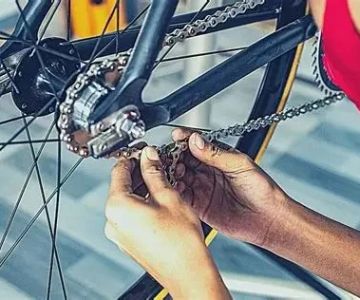
- 1- Why Suspension Fork Pressure Matters
- 2- Steps to Adjust Suspension Fork Pressure
- 3- Tools Needed to Adjust Fork Pressure
- 4- Common Mistakes to Avoid When Adjusting Suspension Fork Pressure
- 5- Tips for Optimizing Your Bike Ride with Proper Fork Pressure
1. Why Suspension Fork Pressure Matters
Suspension fork pressure plays a critical role in the performance and comfort of your mountain bike. The pressure affects how well the fork absorbs shocks, handles rough terrain, and maintains control. Too much pressure can result in a harsh, uncomfortable ride, while too little can make the bike feel squishy and unstable.
Proper suspension fork pressure ensures that the fork responds well to bumps, obstacles, and variations in terrain, offering both comfort and control. It also helps with maintaining balance and ensuring that the bike maintains its optimal performance. The right adjustment of the fork pressure can help you ride more efficiently, reduce the risk of injury, and extend the lifespan of your suspension system.
2. Steps to Adjust Suspension Fork Pressure
Adjusting your suspension fork pressure requires understanding your body weight, the type of terrain you’ll be riding on, and the specifications of your fork. Follow these steps to adjust it correctly:
- Determine your body weight: The first step in adjusting fork pressure is knowing your weight, as it influences how much pressure you need in the fork.
- Check manufacturer recommendations: Most suspension forks come with a pressure chart provided by the manufacturer. This chart will help you match the correct pressure range based on your weight.
- Inflate the fork: Using a shock pump, add air to the fork's air valve. Be sure to add pressure slowly and check the pressure gauge frequently to avoid overinflating.
- Check the sag: Once you’ve set the pressure, check the “sag” of the fork. This refers to the amount the fork compresses under your body weight. Aim for about 25-30% sag, depending on your riding style and terrain.
- Test and adjust: Ride your bike in a controlled environment to test the suspension fork’s performance. If the ride feels too stiff or too soft, adjust the pressure slightly and retest until you find the optimal setting.
3. Tools Needed to Adjust Fork Pressure
Adjusting suspension fork pressure requires a few essential tools, including:
- Shock Pump: This is a specialized pump designed to safely inflate suspension forks and shocks to the correct pressure levels.
- Pressure Gauge: Some shock pumps come with a built-in gauge, but if not, you may need a separate gauge to monitor the air pressure accurately.
- Manufacturer’s Fork Manual: It’s essential to refer to the fork manufacturer’s manual or pressure chart to know the recommended pressure ranges for your specific model.
4. Common Mistakes to Avoid When Adjusting Suspension Fork Pressure
While adjusting your suspension fork pressure, it's easy to make mistakes that can affect your bike's performance. Here are some common pitfalls to avoid:
- Ignoring the Sag: Not checking or adjusting the sag is one of the most common mistakes. Sag plays a crucial role in the suspension's ability to absorb impacts properly.
- Overinflating: Overinflating the fork can make the ride uncomfortable and reduce the fork’s ability to absorb shocks, leading to poor handling and increased wear on the fork.
- Not Using the Right Tools: Using a standard pump instead of a shock pump can lead to inaccurate pressure readings. Always use a shock pump with a gauge for accurate pressure adjustments.
- Neglecting Regular Checks: Suspension fork pressure can change over time due to temperature fluctuations or air loss. It’s important to check and adjust the pressure periodically to ensure optimal performance.
5. Tips for Optimizing Your Bike Ride with Proper Fork Pressure
Proper fork pressure is key to ensuring a smooth and comfortable ride. Here are some additional tips to optimize your bike ride:
- Match Pressure to Riding Conditions: For more aggressive riding or rough terrain, you may need to increase the fork pressure. Conversely, for smoother trails or more casual rides, reduce the pressure to improve comfort and handling.
- Consider Your Riding Style: If you’re doing a lot of downhill riding, slightly more fork pressure may be necessary for better stability. If you're into cross-country, a softer setting may be more suitable for comfort.
- Maintain Your Fork: Regular maintenance of your suspension fork ensures that it performs at its best. This includes cleaning the fork, lubricating the seals, and checking for air leaks.
- Consult Professionals: If you're unsure about the best pressure for your fork, consider visiting a professional bike shop to get expert advice and help with adjustments.
For more detailed information on adjusting your suspension fork or other biking tips, visit Cycling Guider for expert advice and recommended products to enhance your cycling experience.







 New England Bikes4.0 (131 reviews)
New England Bikes4.0 (131 reviews) Velo Cafe - Bicycle Shop4.0 (169 reviews)
Velo Cafe - Bicycle Shop4.0 (169 reviews) Fast : Splits4.0 (50 reviews)
Fast : Splits4.0 (50 reviews) Reds0.0 (0 reviews)
Reds0.0 (0 reviews) Continental Cycles Inc.4.0 (33 reviews)
Continental Cycles Inc.4.0 (33 reviews) Vandruff Fit Solutions5.0 (3 reviews)
Vandruff Fit Solutions5.0 (3 reviews) How to Teach Kids to Ride a Bike: A Step-by-Step Guide for Parents
How to Teach Kids to Ride a Bike: A Step-by-Step Guide for Parents Tips for Riding on Busy City Streets: Smart Strategies for Urban Cyclists
Tips for Riding on Busy City Streets: Smart Strategies for Urban Cyclists Best US National Parks for Mountain Biking: Ride Epic Trails Across America
Best US National Parks for Mountain Biking: Ride Epic Trails Across America Best Aero Helmets for Time Trials and Racing
Best Aero Helmets for Time Trials and Racing How to Clean and Lubricate Your Bike Chain Like a Pro
How to Clean and Lubricate Your Bike Chain Like a Pro 10 Must-Have Items for Long-Distance Cycling Trips
10 Must-Have Items for Long-Distance Cycling Trips